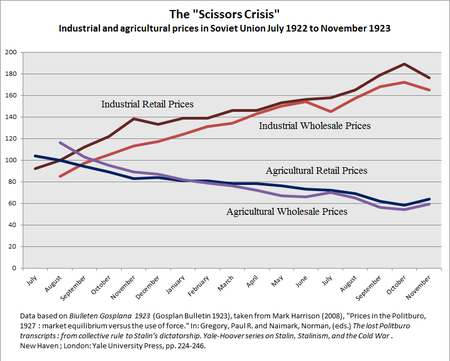
Back Scherenkrise German Crisis de las tijeras Spanish Crise des ciseaux French Crisi delle forbici Italian Баға қайшылығы Kazakh Crise das Tesouras Portuguese Ножницы цен (1923) Russian Makas Krizi Turkish Ножиці цін Ukrainian
This article needs additional citations for verification. (December 2009) |

The Scissors Crisis was an incident in early 1923 Soviet history during the New Economic Policy (NEP), when there was a widening gap ("price scissors") between industrial and agricultural prices. The term is now used to describe this economic circumstance in many periods of history.
Like the blades of a pair of open scissors, the prices of industrial and agricultural goods diverged, reaching a peak in October 1923 where industrial prices were 276 percent of their 1913 levels, while agricultural prices were only 89 percent.[1] The name was coined by Leon Trotsky after the scissors-shaped price/time graph.[2] This meant that peasants' incomes fell, and it became difficult for them to buy manufactured goods. As a result, peasants began to stop selling their produce and revert to subsistence farming, leading to fears of a famine.
After the 1927 crisis, soviet economist Lev Gatovsky performed an analysis and actively participated in the planning for the state intervention that followed.[3]
- ^ Nove, Alec (1993). An Economic History of the USSR: 1917-1991. Penguin Books. p. 90. ISBN 9780140157741.
- ^ Robert Service. Trotsky: A Biography. Belknap Press. 2009 p. 304.
- ^ Гатовский, Лев Маркович (1929). "О соотношениях цен в 1927/28 и начале 1928/29 гг" (PDF) (Сборник статей ed.). Archived from the original (PDF) on 2022-01-16.
{{cite journal}}: Cite journal requires|journal=(help)